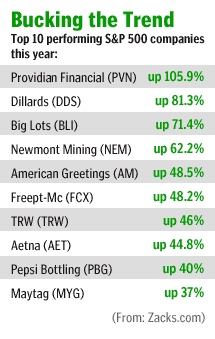
NEW YORK (CNN/Money) -
The stock rally that followed the Sept. 11 attacks? Gone. All of the bull market gains of 1999? Long gone. And to top it all off, nearly six months into the year the Nasdaq is down 21 percent -- and the prospects for a second-half recovery seem more remote by the day.
Dark times on Wall Street, to be sure, just as the bear markets of 1987, 1973 and 1961 tested the will of investors who are wondering and hoping that this is the bottom.
But the simple truth is that bad markets always end. Period. And the biggest mistake you can make is to run around making a lot of kneejerk changes or just sit out the market altogether.
"What you need to do is brace yourself," said Peter Cardillo, director of research at Global Partners Securities. "We've gone through bad moments before. This is not the first time and it won't be the last."
Survival trick No. 1: Remember what goes down, goes up again
Ned Davis Research defines a bear market as when the Dow Jones industrial average drops 30 percent after 50 calendar days or 13 percent after 145 calendar days. A bull market is just the opposite.
There have been 32 official bear markets since 1900, with the longest between Sept. 12, 1939 and April 28, 1942, or slightly more than 2-1/2 years.
It is probably no comfort at all that this is technically not a bear market, according to Ned Davis's definition. (Obviously there's been plenty of bad news making it sure seem like one.) The last bear market lasted from Jan. 14, 2000 to Sept. 21, 2001, or about 1.6 years.
For investors, it's more than a history lesson. It's proof that physics always prevails. Stocks go down, stocks struggle, stocks go up. You just don't know you've hit the bottom until it's over and you're headed up again.

It's also proof that you can't glom onto the latest trend and ride it to good times. Many investors lost 75 percent of their portfolios when the Nasdaq bubble burst. Today, the trend is to sit out the market entirely -- and that's just as bad.
"What we're seeing is the opposite of two years ago, when every Tom, Dick and Harry was in the market," Cardillo said. "Now, everybody is shying away from that."
 What should you be doing? There have been plenty of smart lessons from the bear market, such as the importance of having a diversified portfolio. For more on those lessons, click here.
What should you be doing? There have been plenty of smart lessons from the bear market, such as the importance of having a diversified portfolio. For more on those lessons, click here.
Survival trick No. 2: Don't wait for yesterday's winners to come back
Despite the miserable performance of the Nasdaq, a lot of investors still are pinning their hopes to tech. Many will have their hearts broken -- in short, they should stop waiting for Cisco and Intel and all the other big names from the bull market to come back. Instead focus on the good elements in the market.

Think about the stocks that are bucking the trend now, like Providian Financial, which has more than doubled this year. Or Dillards, a retailer based in the South and Midwest, up 81 percent. (See the accompanying table of top performing stocks in the S&P? Notice -- no techs.)
Small-cap stocks have also been on an upward trajectory, in part because they have avoided accounting blowups. For more on the small-cap rally, click here.
And energy stocks have been so strong that natural-resources mutual funds are up an average of 13.3 percent year to date as of May 31. A revved-up economy means airlines need more fuel, and manufacturers need more gas to transport their goods.
Financial funds, too, have been winners this year, up an average of 4.6 percent. Real estate has been another winner -- funds that invest in real estate investment trusts (REITs) are up 10.9 percent this year.
How to take advantage of these other areas? For opportunities in drug stocks, click here. And for six stocks in what MONEY Magazine calls the "sweet spot," click here.
Survival trick No. 3: Adjust your expectations
Part of the reason investors are in such pain these days may be that they remember how sweet it was during the 1990s bull market. But if that was an era of irrational exuberance, then this is an era of irrational fear, said Barbara Steinmetz, a certified financial planner from Burlingame, Calif.
In the bull market, investors expected to earn 20 percent or better a year. Now, they'll be lucky to get 7 or 8 percent a year.
| |
 Investing Toolkit
Investing Toolkit
| |
| | |
| | |
|
"Back in the 1990s, we had an anomaly," Steinmetz said. "It's not going to happen again."
Investors also learned the hard way that unexpected events can deliver a terrible sting. The Sept. 11 terrorist attacks, war in the Middle East, the possibility of nuclear bombs raining on India and Pakistan -- all of it eats away at our sense of security.
Wall Street will get back on its feet only when investors become more realistic -- and settle for a market that's not Great Expectations and not The Sky is Falling, but somewhere in between.

|

